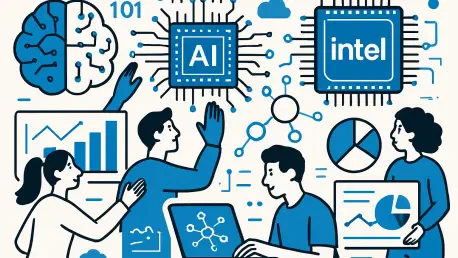What happens when a tech titan like Intel, long a cornerstone of the semiconductor world, finds itself grappling with seismic shifts in an AI-driven industry? Picture a company once synonymous with cutting-edge innovation now facing the urgent need to reinvent itself amidst fierce competition and financial scrutiny. This scenario isn’t just a thought experiment—it’s the reality Intel confronts in 2025, as it navigates a high-stakes restructuring, earnings controversies, and a troubling lag in the artificial intelligence race. The decisions made now could redefine its legacy in a tech landscape that waits for no one.
The importance of Intel’s current trajectory cannot be overstated. As a linchpin of global technology, its ability to adapt affects not just shareholders but entire industries reliant on semiconductor advancements. With competitors like NVIDIA and AMD surging ahead in AI and other transformative fields, Intel’s strategic pivots—ranging from divestitures to manufacturing commitments—carry implications for market dynamics, innovation timelines, and even national interests in tech leadership. This story matters because it reflects broader tensions in an industry where staying relevant demands both bold moves and meticulous execution.
A Tech Giant at a Crossroads: Why Intel’s Moves Matter Now
Intel stands at a pivotal moment, balancing on the edge of reinvention or irrelevance. The company’s recent decisions signal a desperate push to streamline operations and refocus on core strengths while shedding less critical units. Under CEO Lip-Bu Tan’s leadership, the stakes are higher than ever, as every move is scrutinized by investors and industry watchers eager to see if Intel can reclaim its former dominance in a rapidly evolving market.
This urgency stems from a confluence of pressures that have placed Intel under a harsh spotlight. Financial performance, once a given strength, now faces questions amid controversial earnings statements that have rattled confidence. Meanwhile, the company’s struggle to keep pace with AI advancements has left it conspicuously absent from key discussions shaping the future of technology. These challenges aren’t just internal—they’re a litmus test for how legacy giants adapt to relentless innovation cycles.
The broader implications of Intel’s situation resonate across the tech ecosystem. If a company of this stature falters, it could disrupt supply chains, slow advancements in computing power, and cede critical ground to rivals who are already redefining the rules. Understanding Intel’s next steps offers a window into whether traditional powerhouses can evolve fast enough to meet the demands of an AI-centric world.
The Bigger Picture: Intel’s Challenges in a Competitive Industry
Zooming out, Intel’s struggles are not isolated but rather a reflection of seismic shifts within the semiconductor sector. The industry is undergoing a transformation driven by unprecedented demand for AI capabilities, pushing companies to innovate at breakneck speed. Rivals like NVIDIA have capitalized on this trend, dominating markets such as cloud-based AI, while Intel finds itself playing catch-up in areas once considered its forte.
This competitive landscape adds layers of complexity to Intel’s restructuring efforts. Rising costs of advanced manufacturing, coupled with the need to invest heavily in next-generation technologies, create a financial tightrope. Market share is no longer guaranteed, as more agile competitors leverage specialized offerings to capture growth sectors, leaving Intel at risk of being sidelined if it cannot pivot effectively.
Beyond numbers, the stakes involve global technological leadership. Semiconductors power everything from consumer gadgets to defense systems, making Intel’s performance a matter of strategic importance. As nations prioritize tech sovereignty, the company’s ability to maintain relevance amid industry upheaval will influence not just its bottom line but also broader geopolitical dynamics in tech innovation.
Breaking Down Intel’s Triple Challenge: Spinoff, Earnings, and AI
At the heart of Intel’s current narrative are three distinct yet interconnected issues, each highlighting a facet of its strategic overhaul. First, the spinoff of the Network and Edge Group (NEX) marks a deliberate move to shed non-core assets. CEO Lip-Bu Tan envisions this as a way to sharpen focus on primary strengths, echoing past divestitures like Mobileye. Analysts suggest this aligns with a trend of prioritizing high-growth areas over niche markets, with the NEX unit seen as valuable but not central to Intel’s long-term vision.
Second, controversy surrounding the latest earnings call has exposed communication gaps that unsettled markets. Tan’s remarks on the 14A node process were misinterpreted as a potential abandonment, though clarifications indicate a firm commitment to the technology for internal use and external partnerships. With capital costs for advanced nodes soaring—often into billions of dollars—Tan’s push for customer commitments is a pragmatic step to offset expenses, not a retreat from innovation, as some initially feared.
Lastly, Intel’s minimal presence in the AI arena paints a stark contrast to competitors. Notably absent from a recent White House AI event where NVIDIA and AMD took center stage, Intel’s influence in cloud-based AI remains negligible outside personal computing. Analyst data points to a mere fraction of market impact compared to rivals, with products like Gaudi struggling for traction. This gap underscores an urgent need to accelerate efforts in a field defining the industry’s future.
Expert Voices and Industry Insights on Intel’s Direction
To ground these developments, perspectives from seasoned analysts offer clarity on Intel’s path. Jack Gold of J. Gold Associates views the NEX spinoff as a financially sound decision, noting that while the unit serves telecom needs, it represents a small slice of Intel’s potential. He draws parallels to historical exits from communications ventures, suggesting that such moves often free up resources for more impactful investments.
On the earnings controversy, Jim McGregor of Tirias Research argues that the market overreacted to Tan’s 14A node comments. He emphasizes Intel’s ongoing dedication, with early external customers already engaged, framing the CEO’s statements as a call for broader collaboration to manage high development costs. McGregor’s insight helps temper initial alarm, pointing to a strategy of shared risk rather than withdrawal from cutting-edge processes.
Regarding AI, McGregor also highlights Intel’s limited footprint, noting that Gaudi products, despite adoption by firms like IBM, often come at discounted rates or as trial runs, lacking the scale to challenge dominant players. This candid assessment, paired with historical struggles in non-computing sectors, paints a picture of a company needing bold reinvention to regain ground in transformative technologies, a sentiment echoed across industry circles.
Navigating the Future: Practical Strategies for Intel’s Turnaround
Looking ahead, actionable steps could steer Intel toward recovery amidst these multifaceted challenges. For the NEX spinoff, a balanced approach might involve retaining a stake as an anchor investor while forging partnerships with industry players like Ericsson. Analyst predictions support this model, suggesting it maximizes value without fully relinquishing control, allowing Intel to benefit from future growth in networking while focusing elsewhere.
On financial clarity, transparent messaging around initiatives like the 14A node is critical to avoid further missteps. Intel should emphasize dual goals—internal advancement and external collaboration—through consistent updates to stakeholders. This strategy, rooted in offsetting the staggering costs of advanced manufacturing (often exceeding $10 billion per node), could rebuild trust and stabilize market perceptions of its commitment to innovation.
Finally, accelerating relevance in AI demands targeted investments and strategic alliances. Boosting cloud-based solutions and enhancing products like Gaudi through partnerships with tech leaders could close the competitive gap. With AI projected to drive over 40% of semiconductor growth in coming years, Intel must act swiftly to carve out a meaningful role, ensuring it doesn’t remain on the sidelines of a market reshaping global technology.
Looking back, Intel’s journey through this turbulent period revealed a company wrestling with its identity in a transformed industry. The spinoff of non-core units, the clarification of manufacturing commitments, and the stark absence from AI’s forefront painted a complex picture of adaptation under pressure. Yet, these struggles also laid bare opportunities for reinvention. Moving forward, Intel had to prioritize strategic partnerships, clear communication, and aggressive innovation in high-growth areas like AI to reclaim its standing. The path wasn’t easy, but with calculated risks and a renewed focus on emerging trends, there was potential to not just survive but shape the next era of technology.









